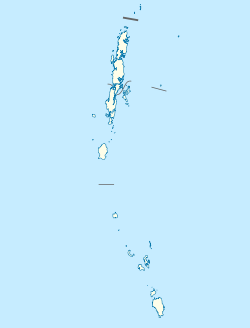卡爾尼科巴語
| 卡爾尼科巴語 | |
|---|---|
| Pū | |
| 發音 | [puː] |
| 母語國家和地區 | 印度 |
| 區域 | 尼科巴群島 |
母語使用人數 | 3.7萬 (2005)[1] |
| 語系 | 南亞語系
|
| 文字 | 拉丁字母 |
| 語言代碼 | |
| ISO 639-3 | caq |
| Glottolog | carn1240[2] |
| ELP | Car Nicobarese |
| 坐標:9°11′N 92°46′E / 9.19°N 92.77°E | |
儘管和越南語和高棉語是遠親,其更可能和臨近的南島語系語言如尼亞斯語和亞齊語有關,它們同屬一個語言聯盟。[3]
卡爾尼科巴語是動賓主語序語言,一定程度上是黏着語。[4]其有相當複雜的動詞後綴系統和一些中綴,如不同的屬格助詞和「疑問」語氣的名詞和代詞。[5]
音系
編輯輔音
編輯| 唇音 | 齒齦音/ 捲舌音 |
硬顎音 | 軟齶音 | 聲門音 | |
|---|---|---|---|---|---|
| 塞音 | p | t | c | k | ʔ |
| 鼻音 | m | n | ɲ | ŋ | |
| 擦音 | f v | s | h | ||
| 閃音 | ɾ ɽ | ||||
| 近音 | l | j |
- 齒齦閃音可以預成阻。在清音前它是清的[ᵗɾ],其他地方是濁的[ᵈɾ]。
元音
編輯| 前元音 | 央元音 | 後元音 | |
|---|---|---|---|
| 閉元音 | i | ɨ | u |
| 半閉元音 | e | ɤ | o |
| 半開元音 | ɛ | ə | ɔ |
| 開元音 | (æ) | a |
- /æ/只出現在英語借詞中。
- 元音在/h/前時音長會變短。[6]
詞彙
編輯保羅·西德維爾(2017)[7]在ICAAL 2017會議上發佈了他的原始尼科巴語。
| 義 | 卡爾尼科巴語 | 原始尼科巴語 |
|---|---|---|
| 熱 | taɲ | *taɲ |
| 四 | fɛːn | *foan |
| 孩子 | kuːn | *kuːn |
| 唇 | (minuh) | *manuːɲ |
| 狗 | ʔam | *ʔam |
| 夜 | hatəːm | *hatəːm |
| 雄性 | koːɲ | *koːɲ |
| 耳 | naŋ | *naŋ |
| 一 | heŋ | *hiaŋ |
| 腹 | (ʔac) | *ʔac |
| 日 | (tavuːj) | - |
| 甘 | (pacaːka) | - |
| 溢出 | tareːci | *roac |
| 鼻 | mɛh | *moah |
| 乳 | tɛh | *toah |
| 咳 | ʔɛhɛ | *ʔoah |
| 臂 | kɛl | *koal |
| 內 | ʔɛl | *ʔoal |
| 四 | feːn | *foan |
| 肘 | sikɔŋ | *keaŋ |
形態
編輯共享形態學交替:老AA型使役動詞h有兩個詞素變體,前綴ha-出現在單音節詞根中,中綴-um-出現在雙音節詞幹中(註釋:聲母*p > h發生在非重讀音節)。
- ɲa - 「吃」 / haɲaː 「餵」
- pɯɲ - 「哭」 / hapɯɲ-ɲɔː 「使哭」
- kucik - 「變得可口」 / kumcik 「嘗」
- kale - 「勇氣」 / kumle 「勇敢」
參考
編輯- ^ 卡爾尼科巴語於《民族語》的連結(第18版,2015年)
- ^ Hammarström, Harald; Forkel, Robert; Haspelmath, Martin; Bank, Sebastian (編). Car Nicobarese. Glottolog 2.7. Jena: Max Planck Institute for the Science of Human History. 2016.
- ^ Cysouw, Michael; Quantitative explorations of the world-wide distribution of rare characteristics, or: the exceptionality of north-western European languages (頁面存檔備份,存於互聯網檔案館); pp. 11-12
- ^ WALS: Nicobarese. [2021-04-07]. (原始內容存檔於2020-12-04).
- ^ Whitehead, Rev. G.; Dictionary of the Car (Nicobarese) language; published 1925 by American Baptist Mission Press; pp. xxvi-xxxii
- ^ Sidwell, Paul. Car Nicobarese. The Handbook of Austroasiatic Languages: Leiden: Brill. 2015: 1231–1240.
- ^ Sidwell, Paul. 2017. "Proto-Nicobarese Phonology, Morphology, Syntax: work in progress". International Conference on Austroasiatic Linguistics 7, Kiel, Sept 29-Oct 1, 2017.

